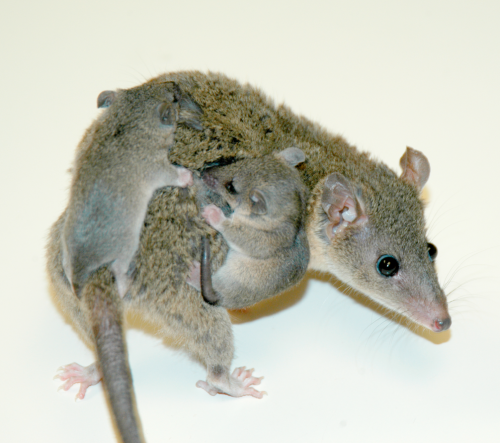Evolution of a novel cell type through rewiring an ancestral stress response
What can opossums tell us about humans? By comparing these species, a research team from Yale University—led by Revson Senior Fellow in Biomedical Sciences Eric Erkenbrack—has shed some light on the evolution of human pregnancy, showing how a novel cell type arose from the rewiring of an ancestral cell stress response.
This research team observed that eutherians, which includes humans and most other mammals, and marsupials (which includes Monodelphis domestica, the gray short-tailed opossum) share a uterine lining cell type: endometrial stromal fibroblasts (HsESF for humans, MdESF for Monodelphis domestica). In humans, pregnancy—a stressor—signals to the ESFs to differentiate into a new cell type, the decidual stromal cell (DSC). However, this differentiation does not occur in marsupials during pregnancy. So how did this novel eutherian cell type arise?
To better understand the evolution of DSCs, the team carried out a comparative study, observing the response of MdESFs and HsESFs to pregnancy hormones. In eutherians, these hormones increase the expression of regulatory genes, including FOXO1, which control the expression of other genes. In this case, differentiation genes are turned on that convert eutherian ESFs into DSCs. After treating MdESFs with pregnancy hormones, the team found that although MdESFs also increase the expression of FOXO1, FOXO1 did not differentiate MdESFs.
Regulation of FOXO1 had thus been maintained from the common ancestor of marsupials and eutherians, but the role of FOXO1 must have changed in eutherians over time. To determine the role of FOXO1 in opossums, the team inhibited MdESFs from expressing FOXO1 and then treated MdESFs with hormones. Without FOXO1 proteins present, the stress induced by pregnancy hormones caused apoptosis—controlled cell death. FOXO1 must therefore be responsible for preventing apoptosis during cell stress in marsupials.
These results suggested that the evolution of eutherian pregnancy led to the evolution of the novel cell type, DSCs.
“I was ecstatic!” Erkenbrack remarked with a smile. “As we were doing the experiments, we started making predictions of how the cells would behave in culture, and those things turned out to be accurate. That’s when we really have feeling that we’re starting to understand something not only about these cells but also about the evolutionary process. That was remarkable.”
The results also filled in some missing puzzle pieces. Past studies had already shown that stress genes were necessary for DSC differentiation, but it was unclear why. Based on the study’s findings, the researchers posited that as the gestation period—the length of pregnancy—lengthened in eutherians relative to marsupials, the ESFs needed a better way to cope with the cell stress brought on by the baby in the uterus. Over time, the ancestral stress response was rewired to cause ESFs to differentiate, rather than just protecting against apoptosis.
“This study gives us a concrete example of how stress pathways—a common pathway that all animals possess—were repurposed for a very specific task, and after that happened, those pathways were further modified,” Erkenbrack said. A study is now underway to confirm a newly developed model that may explain how this novel stress response evolved in eutherian ESFs.

